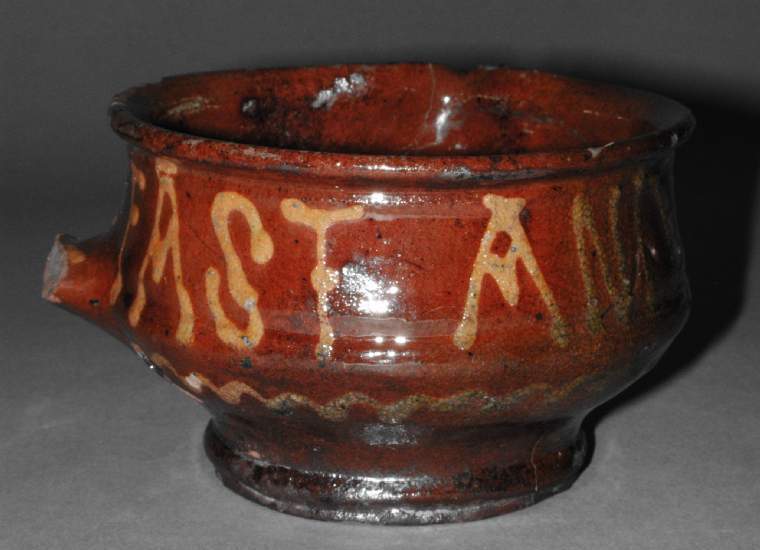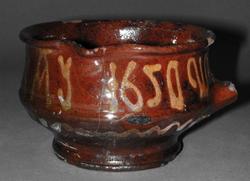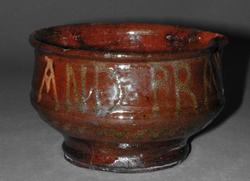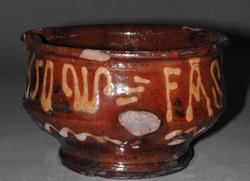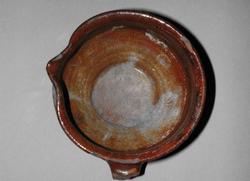Current Location: Gallery 27 (Glaisher)
Maker(s)
Production:
Unidentified Harlow pottery
(Probably)
Entities
Categories
Description
Red earthenware with dark cream slip-trailed decoration under yellowish lead glaze, which does not cover the base inside. Circular with carinated sides and everted rim, standing on a low foot. The mouth is pinched up at one side to form a lip, at right angles to the handle, now missing apart from the stump. Round the upper part, above a wavy line, is the trailed inscription 'FAST AND PRAY 1650 W'
Notes
History note: Alfred P. Billson Collection, Folkestone; purchased by Mr Stoner on behalf of Dr J.W.L. Glaisher at the Billson Sale, Sotheby's, 21 December, 1908, Catalogue of Antiquities and other Works of Art . . ., lot 37, for £5.10.
Legal notes
Dr J.W.L. Glaisher Bequest
Measurements and weight
Diameter: 11.3 cm
Height: 6.8 cm
Acquisition and important dates
Method of acquisition: Bequeathed
(1928)
by
Glaisher, J. W. L., Dr
Dating
17th Century, Mid
Commonwealth
Production date:
AD 1650
: dated
Note
In the 17th century there were potteries making slipware at Carters Mead, Brays Grove, and Latton Street in the area of Harlow New Town
This pipkin (a spouted cooking pot with handle to hold over the heat) is an extraordinarily rare witness to early modern fasting practices. The ‘fast and pray’ inscription would have appealed to the religious radicalism of Puritans living around Harlow during the Commonwealth period (1649–60). The pipkin’s burnished underside indicates that it was used for cooking the kind of meagre vegetable broth recommended for fast days by Thomas Tryon (1634–1703) in his self-help manuals. See also GL.C.36-1928, a slipware square bottle slip-trailed 'IAMES WANEL: ND/FEARE GOD THE LORD/AND FAST AND PRAY/*ABCDEFGHIKLMTHE'.
People, subjects and objects depicted
Components of the work
Decoration
composed of
slip
( white)
Visible Surfaces
composed of
lead-glaze
( yellowish)
Body
Materials used in production
Earthenware
Techniques used in production
Lead-glazing
Inscription or legends present
- Text: FAST AND PRAY 1650 W
- Location: Round upper part
- Method of creation: Slip-trailed
- Type: Inscription
References and bibliographic entries
Related exhibitions
Identification numbers
Accession number: Gl.C.35-1928
Primary reference Number: 77055
Glaisher MS Catalogue: 2957
Stable URI
Audit data
Created: Saturday 6 August 2011
Updated: Friday 1 August 2025
Last processed: Friday 1 August 2025
Associated departments & institutions
Owner or interested party:
The Fitzwilliam Museum
Associated department:
Applied Arts
